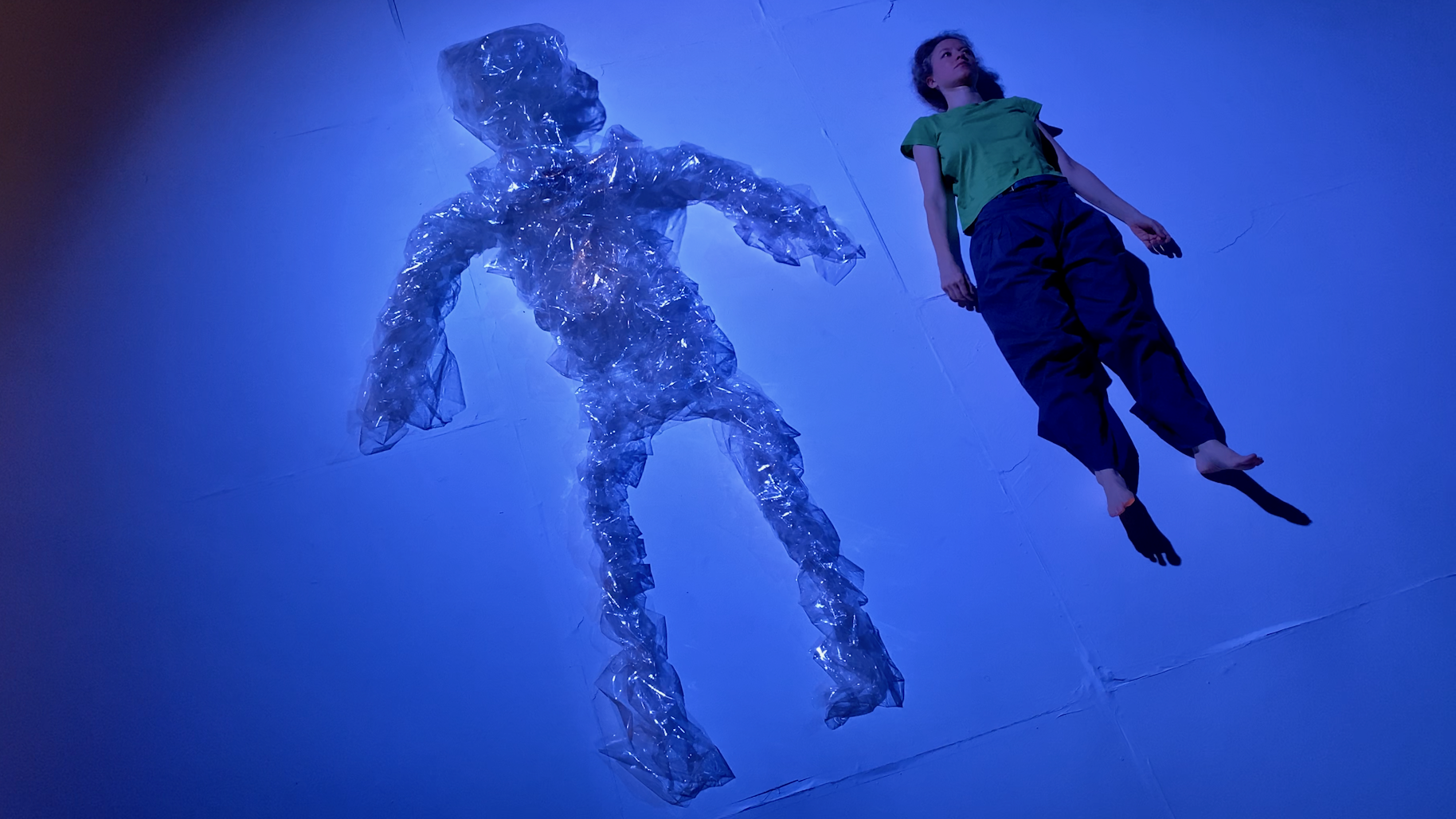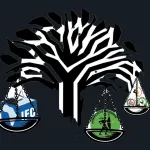MATTERS OF THE ART
Unfathomable – an interdisciplinary and collective inquiry into grief and memory

What are the physical demands and dimensions of grief? In ‘Unfathomable’, the ‘art-as-research film’ adapted from the stage play of the same name, Alex Halligey engages with the material, physical, emotional and social configurations of grief.
A figure appears on stage, and on screen, dancing with a tissue. It’s a tentative choreography – simultaneously precarious and free-flowing – and there’s something about the way she’s dressed, too. Or maybe it’s how she moves in the clothing – fluid and unpredictable movements loosely held by a material ensemble of high-waisted pants and a tightly tucked shirt. The shoes are sturdy, if not a little worn, and the shirt is baggy, somehow, even when it’s tucked in. It’s a size too big, perhaps, and the colour has long since faded, but it’s got an evocative quality to it – the kind of item that holds a particular memory.
What are the physical demands and dimensions of grief? In Unfathomable, the “art-as-research film” adapted from the stage play by the same name, Alex Halligey, the author of the book, Participatory Theatre and the Urban Everyday in South Africa: Place and Play in Johannesburg, engages with the material, physical, emotional and social configurations of grief.
Surfacing grief and memory through choreographed text
In a sentence, Unfathomable is about Halligey’s late father and her attempts to reckon with grief and memory. To tell this story, Halligey uses water, ink, tissue paper, text and the body.
Like most stories about loss, the narrative refuses neat chronology, indulging in frequent forays into deep pools of nostalgia and yearning. Memory is scattered across the city, on road trips, inside hospitals and universities. It’s a narrative that returns always – through water and spoken word – to the body.
It’s a lot for a 40-minute work to carry. The narratives and resonant themes of Unfathomable are held with care, though, and manage to avoid spilling over into relentless sentiment. This is largely owed to the work’s relationship between text and movement.
Halligey worked with the play’s director, Athena Mazarakis, to explore the imagery of some of her pre-existing texts, developing a material language out of them. Props and scenic devices were soon workshopped. While water became a central motif in the work, tissues emerged as a practical translation of grief as well as a material that captured the fragility and formlessness of memory.
Glass jars, which Halligey had used in a previous work, also entered the process early and, once activated through performance, became vessels, rooms, narrative devices and whole worlds in miniature. A process of physical improvisation prompted further writing. Memories, stored somatically, were surfaced through prose and movement.
“Through the process of improvisation, working particularly with an approach of excavating the body as archive, strands of text emerged as the improvisations engaged movement, gesture, voice and language,” explains Mazarakis. “I would take note of resonant phrases, words, images and physical motifs that we would then investigate further. I would ask Alex to improvise further with these phrases or motifs, whether physical or vocal, as specific stimuli for the improvisation. The textual and physical ideas would then evolve, expand or distil further.”
In a scene that serves as a good example of Unfathomable’s blend of scenography, prose, performance, music and film, Halligey stands before the water tank and counts the ways in which one buries someone they have lost. Following on from a scene in which she mimics the act of swimming, the music buoyant and full of life, the view here is of her hands suspended above the water, grabbing tissues, dropping them in.
“You bury someone when you make a play about them. When you write a poem about them,” she declares, dropping a tissue into the tank. It hits the water and rests, briefly, on the meniscus before being pulled under by its own weight. “You bury someone when you tell someone else that they are dead, when they died, what they were to you.”
The view is of the tissue now, fully submerged, floating and flailing, turning and sinking. In the silence, it is like a body or a spectre, twisting in the light. It is an extraordinary and deeply affecting scene where the water, that familiar place of freedom and respite for Halligey, turns vast and overwhelming, heavy with grief.

Still from ‘Unfathomable’. Image: Supplied
Hybrid film and theatre tactics
Unfathomable has had many lives. Originally devised by Halligey and Mazarakis as a stage play that debuted at the 2019 National Arts Festival, it was later filmed and uploaded as a series of short videos for the virtual iteration of the festival in 2020. This latest version is an attempt at reconciling the two.
Filmed theatre is risky business. Simply put, it’s far too easy to lose the fundamental thing that people go to the theatre for: the energy and particular pathos that comes with live performance. Worse still, the theatre-film often runs the risk of coming off as gimmicky, full of dramatic cuts and scene changes that never quite translate from the stage to the screen. So, how does Unfathomable deal with it all? Nicola Pilkington, Unfathomable’s videographer and editor, says that editing has a lot to do with it, as does technology.
Pilkington filmed the whole thing on an iPhone using a gimbal, “a light-weight responsive instrument that could gently glide and move with Alex around the space”, she explains. “Not only did this allow for the camera to easily experience the action from below, above, or alongside Alex; but it also got an intimate, almost textural experience of the movement and the objects.”
A number of scenes and smaller filmic moments are testament to this. Water churns and swirls as it’s poured from one vessel to another. Tissue paper fattens and floods, rupturing its fibres and taking on the shape of a blanket, a jellyfish, a pulpy paper doll. Halligey crouches and crawls, holds a story in a glass jar and dances with the tenuous and fragile quality of paper and memory. Later, she submerges her face in a body of water, bubbles streaming from her nostrils before she surfaces breathless, disorientated, rejuvenated.
Importantly, these scenes manage to hold a lot of the immediacy and the presence of theatre. They feel alive and full of risk. There is the fear of falling or fumbling or forgetting one’s lines, one’s choreography on stage. In this way, there are the kinds of “live” moments that are inherent to theatre, but foreign to traditional film.
Water, of course, is the dominant material in Unfathomable. Creating a body of water on stage, then, was vital. It was the task given to set designer Jenni-Lee Crewe at Unfathomable’s inception and the challenge was twofold: solving the practical problem of containing water on stage but also representing a body made of water, through the play’s set.
Crewe worked remotely from Cape Town, sending images, ideas, designs and materials up to Halligey and Mazarakis to work with at the Ebhudlweni Arts Centre in Mpumalanga. Ultimately, the trough of water emerged, suspended on pulleys and allowing Halligey to interface with the device in various ways, while also presenting a range of possibilities for lighting.
“It was interesting for me to notice changes in space, materiality and effect in the film version,” says Crewe. “The effects of the material manipulations (water, plastic, tissues) in the stage version needed to be projected outwards, whereas the film version invited the audience into the qualities of the materials via close-ups and point of view.”
A head plunged and streaming bubbles glimpsed from below, a sea of swirling tissues from above, or the slow, colossal movement of water flooding the frame. If water is the thematic throughline of the work, the trough is something of a wellspring.
An interdisciplinary and collaborative way of working
Like any good theatre production, Unfathomable is the result of a dedicated team of artists, disciplines and ways of working. It embraced collaboration.
The practical collaborations – music responding to visuals, or lighting echoing an emotional quality – are self-evident. But it’s the secondary act of collaboration that emerged through Unfathomable that becomes more interesting. The level of trust that composer Daniel de Wet felt he was granted when responding to the work, musically, afforded him a greater level of freedom, he says. As a result, the lightness of his keys – a musical interpretation of droplets hitting the water – becomes an incidental cue in the editing process, a prompt to transition to the next scene. For Pilkington, who moves between the film and theatre worlds often, the process was instructional. Learning to breathe and move with Halligey in the space, for example:
“I felt like we were co-navigating our movements like a dance, rather than purely accommodating the camera for the performance, or vice versa.”
Perhaps co-navigation can be seen as something of a key to the work. Unfathomable isn’t an interesting project because of its relatively novel transition from stage to screen, but rather because of its capacity for co-navigation and participation – it’s ability to invite others into the process, be it the viewer or the collaborator, and generate new meaning.
Considering its central themes, revisited and refined through a global health pandemic, it’s a piece that will resonate, albeit differently, with anyone who has experienced loss. And in a time of converging socioeconomic and ecological crises, where loss is the prevailing narrative, perhaps making sense of grief has become more of a collaborative act than before. DM/ML
Unfathomable is available to watch online until 30 December 2022. Tickets are available here.
Visit Daily Maverick’s home page for more news, analysis and investigations

















 Become an Insider
Become an Insider
Comments - Please login in order to comment.